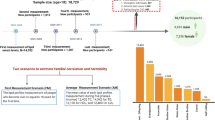Abstract.
Segregation analysis was performed on the serum uric acid measurements from 523 randomly ascertained Caucasian families from the NHLBI Family Heart Study. Gender-specific standardized residuals were used as the phenotypic variable in both familial correlation and segregation analysis. Uric acid residuals were adjusted for age, age2, age3, body mass index (kg/m2), creatinine level, aspirin use (yes/no), total drinks (per week), HOMA insulin resistance index [(glucose * insulin)/22.5], diuretic use (yes/no), and triglyceride level. Sibling correlations (r=0.193) and parent-offspring correlations (r=0.217) were significantly different from zero, but these two familial correlations were not significantly different from one another. After adjustment for covariates, the heritability estimate for serum uric acid was 0.399. Segregation analysis rejected the "no major gene" model but was unable to discriminate between an "environmental" and a "Mendelian major gene" model. These results support the hypothesis that uric acid is a multifactorial trait possibly influenced by more than one major gene, modifying genes, and environmental factors.
Similar content being viewed by others
Author information
Authors and Affiliations
Additional information
Electronic Publication
Rights and permissions
About this article
Cite this article
Wilk, J., Djousse, L., Borecki, I. et al. Segregation analysis of serum uric acid in the NHLBI Family Heart Study. Hum Genet 106, 355–359 (2000). https://doi.org/10.1007/s004390000243
Received:
Accepted:
Issue Date:
DOI: https://doi.org/10.1007/s004390000243




